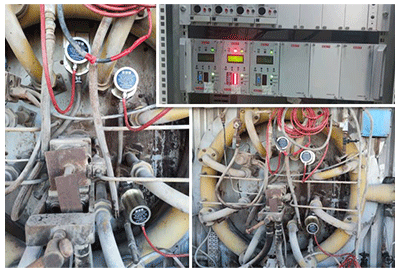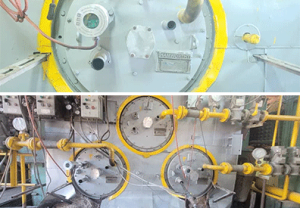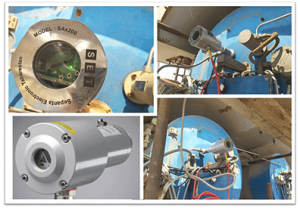AGD01 Series, Installation And Application Guide
The Flame sensor AGD01 series monitors and analyses the flame features via the pulse signal of the connected sensor unit. The easy-to-read LCD display continually shows information on the defined setting and operational status. The flame intensity is presented at a current output 0.4…20mA for further analysis. There are three types of monitor units can connect to AGD01 sensor unit AGD01-Tix, AGD01-Tiy, AGD01-DU . Parameters of the monitor unit can be transmitted to a PC via a an Isolated RS232 interface. In this Article, we will explain how to set up the sensor and monitoring unit and how to interpret what the LCD displays. Moreover, by the following link , you can visit all products and type of flame scanner produced by Sepanta electronic Tabarestan.
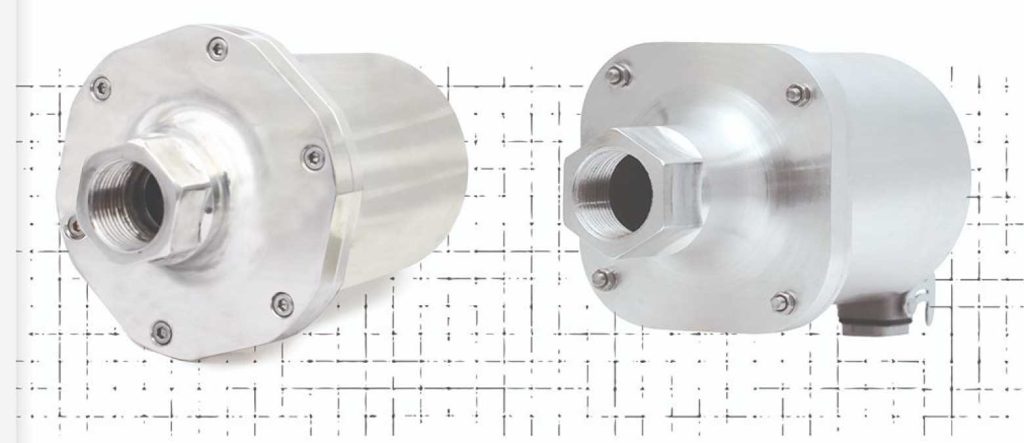

Fig 1) Flame sensor and monitor unit
AGD01 Flame Scanning System Components
AGD01 comprises of two units (Fig 2):
- Flame sensor unit
- Flame monitor unit
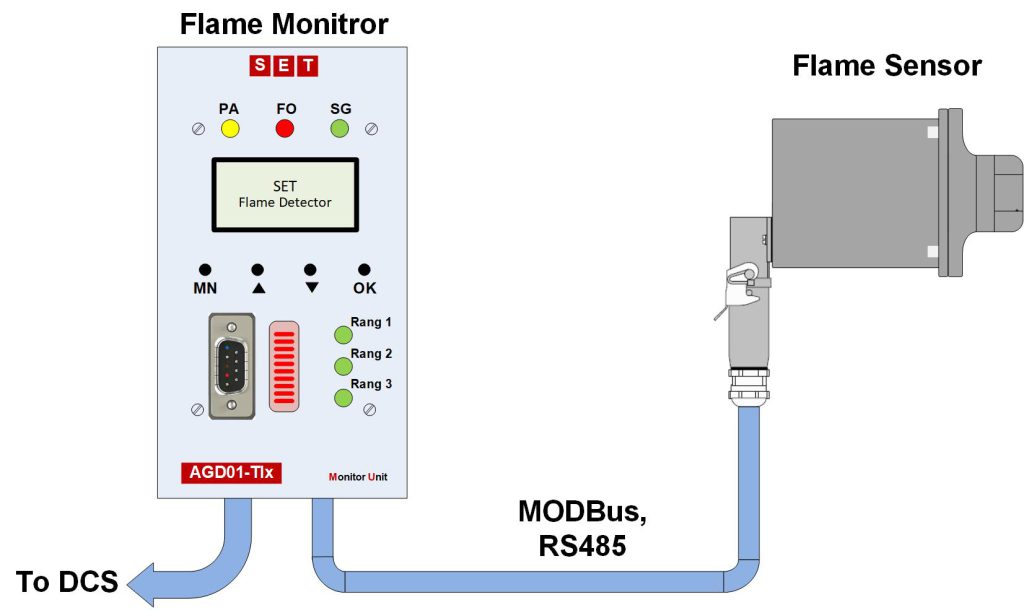
Fig 2) Flame sensor and monitor unit
The sensor receives the optical waves emitted from the flame through a side glass in the combustion chamber, and converts it to the electrical signal by a opto-detector. Then, the signal received from the opto-detector is analyzed in the digital processor and the features of the flame quality are extracted. The flame quality features are sent to the flame card via a RS485 network. The system is capable of operating in severe temperature conditions such as 85 ° C
AGD01 Advantages
A digital 32-bit ARM family processor is used in AGD01 (Fig 3). In addition to performing the main task of Flame Scanning, this processor also offers the following new features:

Fig 3)Processing Diagram Of AGD01
- The digital scanner is capable of recognizing the percentage of optical spectrum, i.e. how much of the received spectrum from the flame is UV and how much is IR. With this feature, it is possible to measure the flame quality inside the combustion chamber and compare it with an ideal flame.
- The ability to detect the flame intensity inside the combustion chamber.
- The digital scanner has a special software that can detect flame status and check it by connecting to the monitoring card (fig.7).
- Temperature recording inside the scanner in the long run allows to check the temperature inside the scanner. Thus, the issues of the side glass cracking and hot air leakage can easily be detected by checking the scanner temperature.
- Digital data transfer in physical layer of RS485 and Modbus protocol. This method of transferring data is immune to the environmental noise, and the destructive effects of disturbing signals is very low.
Opto-detector
One of the methods for detecting flames is using opto-detector. By receiving light, opto-detectors generate electrical signals. The higher the light intensity, the larger the amplitude of the signal output of this sensor. Thus, it is easy to distantly detect the flame using this type of sensor.
The biggest problems in applying opto-detectors for detecting flame are the disturbances caused by background light and also, sensor’s behavior changes along with the temperature. Radiation of infrared rays from hot objects is easily measured by opto-detectors. This optical spectrum is also emitted from hot objects in the absence of a flame, which easily leads to a false decision regarding the existence or absence of the flame. The background light caused by sunlight, tungsten bulbs and fluorescent lamps also complicates the flame detection. Though, due to the closed gas turbine, the environmental lighting is not very effective. Anyway, to prevent these disturbances, the best method for detecting flames is measuring the flame’s periodical and instantaneous variations. This feature is known as flame flickering. Figure3 shows the flame on the output of a burner.
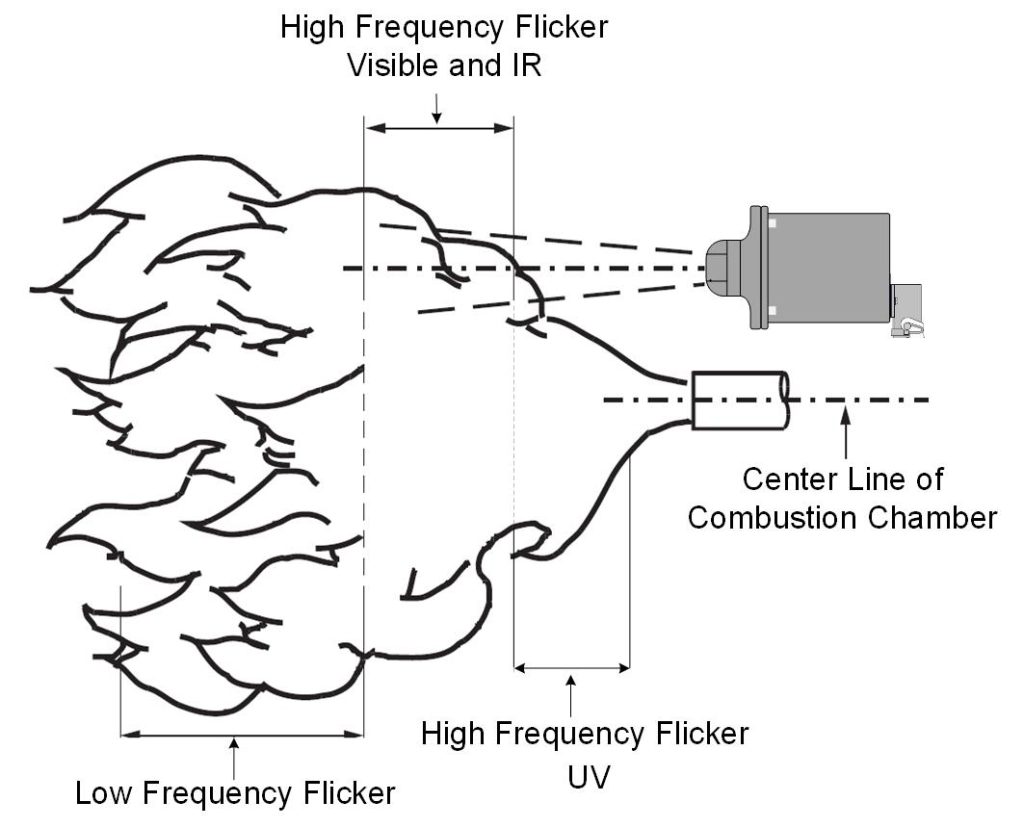
Fig 4) Flame flickering at a burner
The flame can usually be divided into three regions at the burner output. The region close to the fuel output, which its optical spectrum is often in the UV range, and flame flickering frequency is high. If the turbine fuel is diesel or mazut, the intensity of this spectrum is reduced and the optical spectrum goes to the visible area. The optical spectrum of the middle region of the flame is visible and infrared light with a high flickering frequency. The third region is the flame end, whose optical spectrum is slightly in the visible area and more in the infrared region. The flickering frequency of the flame light is low in this region.
The AGD01 scanner is used different types of photodiodes and vacuum tube as opto-detector. The type of fuel and combustion chamber determine which optical spectrum to use for scanner (Table 1).
Table 1) Optical spectrum of the flame sensor and its application
|
Feature |
Suitable for fuels |
Spectrum |
Part Number |
||||
|
GAS |
OIL |
COAL |
WOOD |
H2S |
|||
|
Highly sensitive and selective monitoring of gas and oil flames |
•• |
• |
Narrowband UV |
AGD01-S18C |
|||
|
Selective monitoring of a single burner of oil and gas flames in multi burners chamber with low NOx combustion ideally suited for Multi-Flame Burner |
• |
•• |
• |
UV |
AGD01-S22C |
||
|
combustion chamber flame monitoring (coal, oil) |
• |
• |
•• |
• |
Visible |
AGD01-S23C |
|
|
combustion chamber flame monitoring, Ideal for monitoring oil burners which have insufficient UV radiation caused by NOx reducing methods ideally suited for Gas Turbine |
•• |
• |
• |
•• |
IR |
AGD01-S21C |
|
UV Flame Scanner AGD01-S18C
AGD01-S18C is our UV flame scanner best suitable for UV spectrum detection in multi-burner furnaces and boilers. But since it uses a UV lamp, it requires a higher level of maintenance. UV lamps lose intensity over time. Therefore, most systems specify a replacement interval often every 12–24 months for industrial, depending on lamp Track lamp life and keep a replacement schedule.
UV Flame Scanner AGD01-S22C
AGD01-S22C is our UV flame scanner best suitable for UV spectrum detection in multi-burner furnaces and boilers, using UV photo diode sensor.
IR Flame Scanner AGD01-S21C
AGD01-S21C is our IR flame scanner best suitable for visible spectrum detection in single-burner furnaces and boilers, using visible photo diode sensor. When flame detection is critical and flame intensity is so low, we recommend the S21C series
visible Flame Scanner AGD01-S23C
AGD01-S23C is our flame scanner best suitable for visible spectrum detection in coil and oil burners, using IR photo diode sensor. Where accuracy and durability are critical, we recommend the S23C series.
Flame characteristics
A sample of the flame opto-detector output signal is shown in Fig 5. Features that could be extracted from this signal include flame intensity, flame flickering intensity, and flame flickering frequency.
The flame intensity is the average value of the sensor output signal.
The flame flickering intensity is the alternating amplitude of the sensor output signal.
The flame flickering frequency is the frequency of the alternating signal of the sensor output.

Fig 5) Intensity, amplitude, and frequency of the flame flicker.
These three features of the flame are easily extracted by the digital processor. However, as mentioned earlier, to prevent any environmental optical disturbances, measuring the flame flickering intensity is the best method for detecting flame status.
Input / Output Signals Of The Sensor Unite
The electrical connection of the sensor unite and flame analysis card is carried out by a 5-string cable. Two strings are for 24V voltage supply from the analysis card to the flame detection unite. Three strings are for RS485 serial connection physical platform. ModBus protocol is used for making connection in RS485 physical platform. In the system, analysis card and sensor are configured as master and slave, respectively. In order to minimize circuit noise in this string cable, the earth wire of power supply unit is separated from the RS485 ground (Fig 6).

Fig 6) Cable connection of the flame detector.
Output data from the sensor includes flame features which is sent to flame analysis card by the serial line. The data is displayed in Table 2.
Table 2) Data sent from Sensor to Analysis Card
|
Range |
Data |
|
0 … 999 |
The amount of flame density |
|
0 … 999 |
The amount of flame density/13 |
|
0 … 999 |
The amount of flame brightness |
|
0 … 500Hz |
Flame flickering frequency |
|
-20 … +100oC |
Sensor temperature |
|
Well/damaged |
Flame sensor state |
Input/output Signals Of The Flame Analysis Card
.The flame analysis card has a major terminal and a peripheral terminal for RS232 serial connection
Input/output signals in the major terminal of the flame card are shown in Fig 7. Input/output signals of the sensor are shown in Fig 8.The data in Table 3 is provided in the central control room with RS232 protocol for the user.
Table 3) sent data from flame Monitor to central controlling system of the flame protection
|
Range |
Data |
|
0 … 999 |
The amount of flame density |
|
0 … 999 |
The amount of flame brightness |
|
0 … 100 |
The amount of flame intensity |
| 0 … 500Hz |
Flame flickering frequency |
|
-20 … +100oC |
Sensor temperature |
|
Well/damaged |
Flame sensor state |

Fig 7) The output major terminal in the monitor Unit.
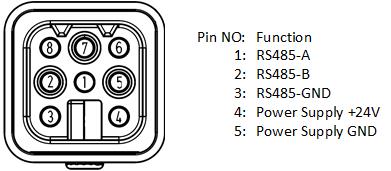
Fig 8) The output connector of sensor unite (Hurting Connector).
Also, by the Flame Scanner Explorer software, the data can be observed directly (Fig 9).
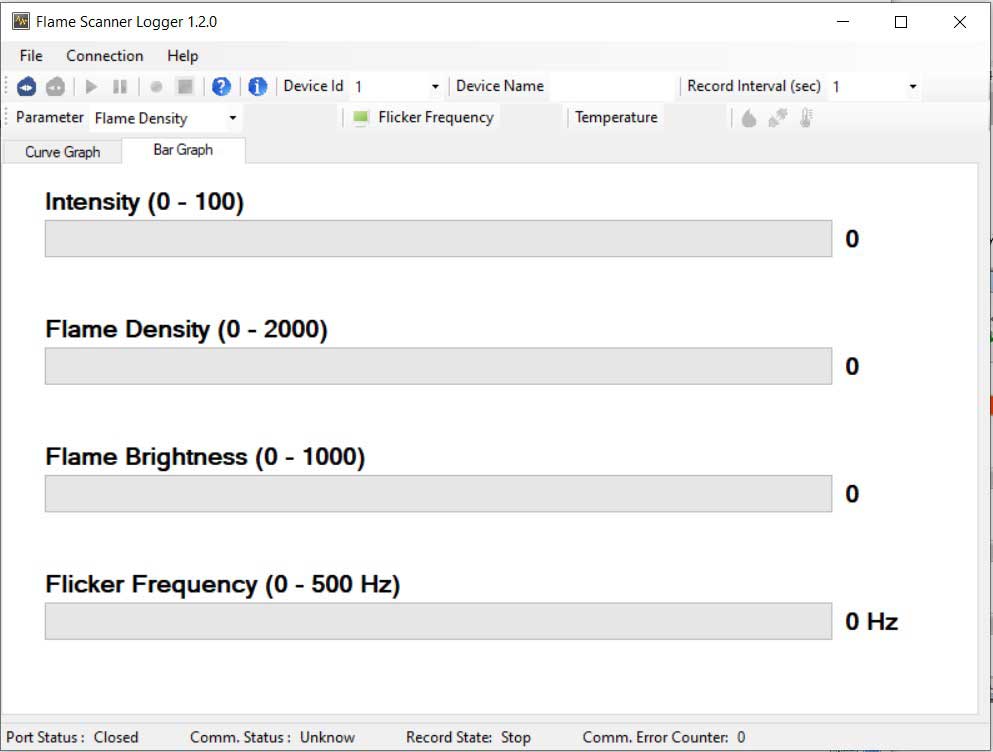
Fig 9) The main page of Flame Scanner Explorer software.
Installation and start-up
The flame analysis card is installed on the rack 19 inside the control panel or on the wall. The installation location of the card should be in such a way that it does not have any vibration.
The flame scanner has such strict body that makes installation easy. The screws on the scanner must be tightened by the nuts so that it does not open due to vibration. It is best to use a cylindrical flange to connect the scanner to the combustion chamber and the scanner’s visibility.
Angle should be adjusted in a way that the flame can be seen for all loads. The visual aperture of the flame should be as close to the flame as possible. The best angle of installation of the visual aperture of the flame is that it is visible from the first one-third to the middle one-third of the flame root at all various loads under the angle of 3 to 15 degrees. The length and diameter of the visual aperture of the flame exerts a direct influence on the flame evaluation, since it determines visibility angle of the scanner’s sensor. With this visibility angle, the scanner senses a particular section of the flame. Use a thermal insulation for a flame scanner if the visual aperture is in high temperature.
To install the cable between flame analysis card and flame scanner on long paths, the use of a 6-wire cable (two of which have separate shields) is recommended to avoid noise interference. The intended cable must have the required resistance to the oily, acidic materials and tolerate the temperature between -20 ° C and + 80 ° C.
The following points should be considered when installing the cable:
- The intended cable should not be parallel to the high-voltage cable. If this is inevitable, observe the minimum distance between them.
- The cable shield must be connected to the intended reference at the end of the path with the minimum resistance and inductance.
- All wires of cable and shield of flame systems must be isolated from each other. Only one connection with low leakage resistance is permitted on the electronic earth.
Guidelines for observation and adjustment of the analysis card
As mentioned earlier, digital flame detector has many potentialities. This potentiality can be observed and adjusted in the flame monitor pages. The flame monitor page and its components are brought in Fig 10.
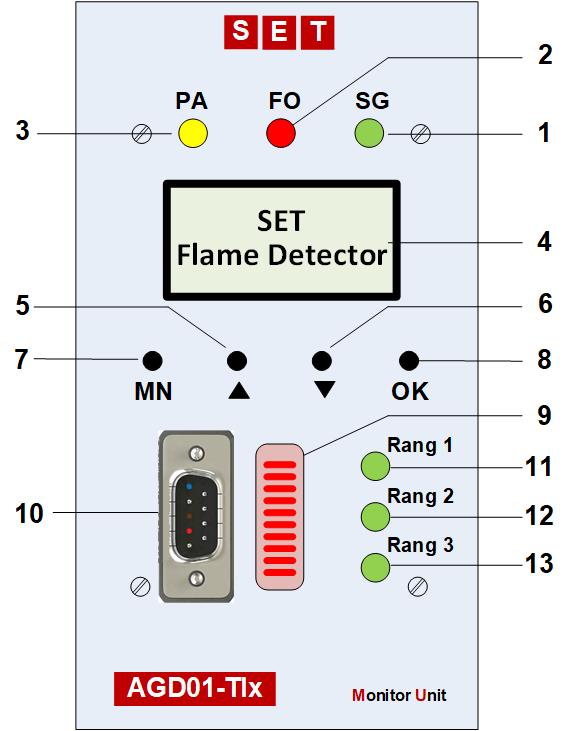
Fig 10) Flame monitor page and its components
The flame monitor page components include:
- System Good indicator LED (SG)
- Flame OK indicator LED (FO)
- Pre-Alarm indicator LED (PA)
- LCD Display
- upper switch (˄)
- Lower switch (˅)
- Menu switch
- OK switch
- LED Bar indicator
- RS232 Serial port
- Rang1 indicator LED
- Rang2 indicator LED
- Rang3 indicator LED
1.System Good indicator LED
If this LED is constantly on, it means there is no fault in device performance. If this LED is flashing, it means there is one or more fault conditions in the device performance. In the case of an error, the corresponding error can be observed on the error display page. Errors include no connection to the flame sensor or a temperature higher than 85 degrees Celsius in the flame sensor.
2.Flame OK indicator LED
When this LED is on, it means the existence of a flame which its flickering intensity is greater than the amount of flame-on declaration point, which is adjustable by the user. When this LED is off means the lack of proper flame.
3.PreAlarm indicator LED
In the case that analysis card detects the existence of a proper flame, the flame flickering intensity is less than pre-fault declaration point (which is adjustable by the user), hence, this indicator would turn on. If the flame is in a proper condition or there is no flame, this indicator would turn off.
4.Upper and lower switches
Upper (˄) and lower (˅) switches are for increasing and/or reducing adjustable parameters and also, for observing display pages.
5.Menu switch
Menu switch is for entry to setting section and back to display section.
6.OK switch
Ok switch is for setting confirmation and storage.
7.LED Bar indicator
LED Bar indicator is for displaying flickering intensity with the percentage unit. This indicator has 10 lights, each of which is indicative of 10 percent intensity value.
RS232 Serial port
A serial port for online monitoring of values on a computer by the device, as well as receiving stored data in Flame Analysis Card. This port includes DB9 conductor of FEMAIL type. The base sequence of this port is identified in Table 4. The connection layer of this port is RS232 and connection protocol are MODBUS RTU. The serial connection features are 19200, E,8,1.
Table 4) RS232 port feature
|
Signal |
Base no. |
| RX | 2 |
| TX | 3 |
| GND | 5 |
